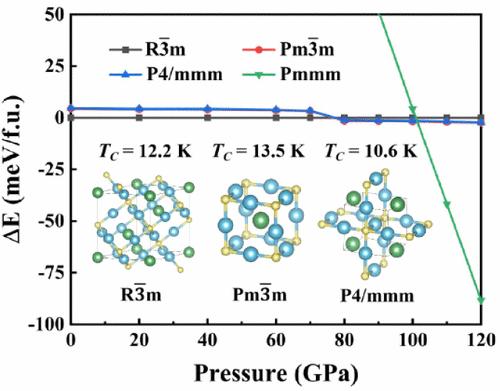反钙钛矿ZnNNi3:一种低压超导体的高压结构演化与超导性
IF 3.2
3区 化学
Q2 CHEMISTRY, PHYSICAL
引用次数: 0
摘要
受最近关于钙钛矿和反钙钛矿高压结构多样性的报道的启发,我们对反钙钛矿ZnNNi3在0到120 GPa压力范围内的结构演变、电子性能和超导性进行了全面的研究。利用VASP包对CALYPSO晶体结构搜索方法和其他相关文献获得的大量结构进行充分松弛。计算结果表明,成功地预测了4个稳定相R3′m、Pm3′m、P4/mmm和Pmmm。在0 ~ 120 GPa的压力范围内,ZnNNi3经历了两次重构相变:第一次是从R3′m相到Pm3′m或P4′m相(77 GPa),第二次是从Pm3′m或P4′m相到Pmmm相(101 GPa)。更重要的是,对电子性质的分析表明,R3、Pm3和P4/mmm相保留了金属丰度,并在费米能级上表现出高密度的态,这意味着它们可能具有良好的超导性质。随后,进一步的超导分析表明,R3、Pm3和P4/mmm相的超导转变温度(Tc)在零压下分别为12.2、13.5和10.6 K。这些值高于Ca3PN和RbPbI3的报道值,并且该材料相对容易实验合成。这些发现强调了ZnNNi3作为低压超导体的潜力,并为未来探索具有增强超导性能的反钙钛矿材料提供了有价值的见解。本文章由计算机程序翻译,如有差异,请以英文原文为准。

The High-Pressure Structural Evolution and Superconductivity of Antiperovskite ZnNNi3: A Low-Pressure Superconductor
Inspired by recent reports on the diversity of high-pressure structures for perovskites and antiperovskites, we performed a comprehensive investigation of the structural evolution, electronic properties, and superconductivity of antiperovskite ZnNNi3 under pressures ranging from 0 to 120 GPa. The VASP package is employed to fully relax a large number of structures obtained by the CALYPSO crystal structure searching method and other related references. The calculated results indicate that four stable phases─R3̅m, Pm3̅m, P4/mmm and Pmmm─are successfully predicted. At pressures ranging from 0 to 120 GPa, ZnNNi3 undergoes two reconstructive phase transitions: the first, from the R3̅m phase to the Pm3̅m or P4/mmm phase at 77 GPa, and the second, from the Pm3̅m or P4/mmm phase to the Pmmm phase at 101 GPa. More importantly, analyses of the electronic properties reveal that the R3̅m, Pm3̅m, and P4/mmm phases retain metallicity and exhibit a high density of states at the Fermi level, implying that they may possess good superconducting properties. Subsequently, further superconducting analysis indicates that the superconducting transition temperatures (Tc) of the R3̅m, Pm3̅m, and P4/mmm phases are predicted to be 12.2, 13.5, and 10.6 K at zero pressure, respectively. These values are higher than those reported for Ca3PN and RbPbI3, and the material is relatively easy to synthesize experimentally. These findings underscore the potential of ZnNNi3 as a low-pressure superconductor and provide valuable insights for the future exploration of antiperovskite materials with enhanced superconducting properties.
求助全文
通过发布文献求助,成功后即可免费获取论文全文。
去求助
来源期刊

The Journal of Physical Chemistry C
化学-材料科学:综合
CiteScore
6.50
自引率
8.10%
发文量
2047
审稿时长
1.8 months
期刊介绍:
The Journal of Physical Chemistry A/B/C is devoted to reporting new and original experimental and theoretical basic research of interest to physical chemists, biophysical chemists, and chemical physicists.
 求助内容:
求助内容: 应助结果提醒方式:
应助结果提醒方式:


